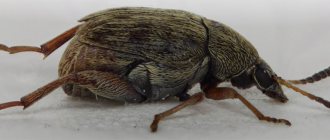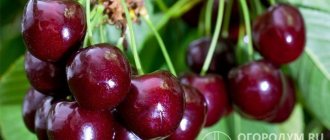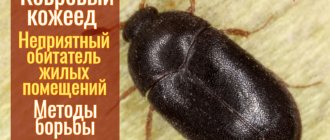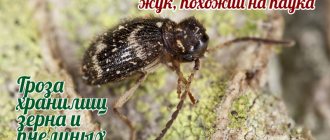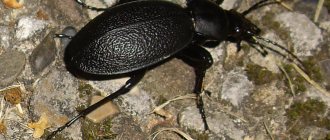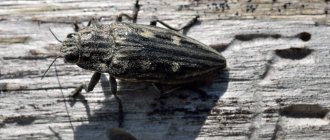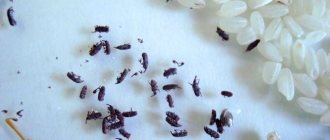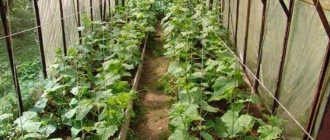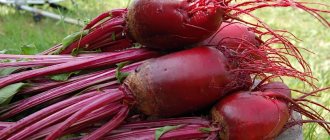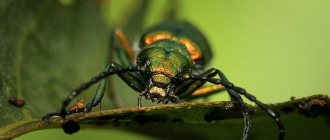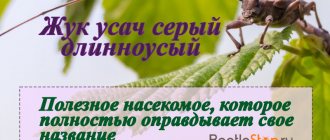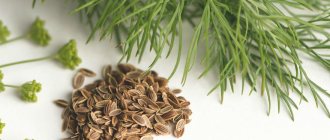Every gardener who grows peas on his plot is likely to encounter such a common pest as bruchus. It is also sometimes called pea weevil, emphasizing the beetle’s love for this crop. The main damage is caused by the larvae that feed on nutritious beans (plants), while adults prefer flower pollen. A sure sign of the “work” of the bruchus is the small holes in the pea fruits that appear during storage.
Getting to know the insect
Bruchus belongs to the family of beetles called Coleoptera in Latin. It is small in size: the body length of adult individuals in the adult development phase is usually 0.4–0.5 mm.
In the photo of Bruchus, under magnification, 11-segmented antennae and 2 pairs of tarsi are visible, the first of which are turned forward, and the rest - backward.
Bruchus beetle
The body of the beetle is covered with small gray hairs, although it itself is black. The legs and antennae differ in color: they are partly yellow, often with a reddish tint. The head of Bruchus is relatively small. The pronotum is protected by a shield, and on the elytra of this beetle there are white spots resembling a cross in shape. This special pattern is what distinguishes the bruchus from other millstones.
The beetle's head has an elongated shape, which makes it look like a weevil. In English, the insect is even called “pea weevil” (pea weevil), which is incorrect from the point of view of biological classification...
Chemical methods
Processing peas using industrial chemicals is considered the most effective. Among them:
- Carbonation. The destruction of bruchus must begin immediately after harvesting, when the pea plant has not yet left the larval phase. If the moisture content of peas does not exceed 16%, liquefied methyl bromide is used for fumigation in a volume of 30 grams per m2.
The fight against bruchus is carried out only by specialists in sealed granaries or under a tarpaulin. The thickness of the pea layer should be no less than 75 and no more than 150 centimeters. Standard processing times are 1-2 days, depending on the air temperature. The procedure does not lead to loss of germination.
- Disinfection of seed material with hexachlorane. When the humidity level is below 15%, the seed material is treated with 12% hexachlorane dust. The drug is formulated using 3 kilograms per 1 ton. The treated seeds are covered with tarpaulin or polyethylene and left for 7-10 days. Beetles die after treatment no later than 3 days. When deciding when to poison, you should remember that the most favorable time here is spring, about a month before the start of sowing, or autumn, even before the first frost. When the procedure is carried out correctly, germination does not decrease, and the percentage of dead bruchus ranges from 87 to 100.
- Spraying pea crops. For these purposes, they use an insecticide such as 2.5% dust metaphos. The procedure is repeated twice. The consumption is 20 kilograms per 1 hectare during the first treatment session and 10 kilograms per hectare during the second.
It is necessary to spray once before the pest begins laying eggs, and a second time approximately 10 days after the first. Treatment is not allowed if there are flowering weeds in the crops. Pollination is also carried out using small aircraft and various systems of ground pollinators, but with a working width of at least 20 meters. Since the period for spraying metaphos is relatively short, treatment with this product is acceptable two weeks before the start of harvesting.
The most effective drugs are considered to be:
- 20% metaphos emulsion;
- 80% chlorophos solution;
Chemical treatment of peas intended for canning is strictly prohibited.
When the population size of the weevil is small, edge treatment of crops is considered advisable, since these are the zones that are colonized by the pest as a matter of priority. Its efficiency is quite high; the level of contamination of seed material does not exceed 0.07%.
The methods listed above give a complete picture of how to deal with bruchus most effectively.
Life of Bruchus
Bruchus is a beetle whose historical homeland was southern countries with a warm climate. But today it is a cosmopolitan insect that has successfully spread to areas around the world where its favorite food, peas, is grown. Its habitat has changed, according to biologists, due to human activity, which transported bruchus from continent to continent along with legume supplies.
This species can be called “monogamous” in the choice of food, although they also spread over territories with reserves of crops similar to peas: beans, vetch, chickpeas, lentils, beans, etc. But Bruchus females never lay their larvae, which feed on fruits; on these plants. Therefore, other legumes, unlike peas, are not threatened by this pest.
Wintering
Bruchus, due to its southern origin, has difficulty withstanding winter frosts. In central Russia and neighboring countries, larvae and beetles wait out unfavorable weather in insulated barns, warehouses, and granaries, waiting for the spring sun to warm up the air. They hide in nooks, crevices of the floor or walls.
In regions with warmer climates, the picture is different: beetles leave peas already in the autumn months. To survive the winter, bruchus chooses fallen leaves, hay and straw for shelter. Some individuals even go straight to the pea fields, escaping from the cold in the plant debris left after the harvest.
A new stage in the life of Bruchus begins at the end of April-May, when the beetles leave their shelters, scattering around the area. They prefer areas well illuminated by sunlight: gardens, fields, vegetable gardens, forest belts. Only part of the pest ends up in areas where peas are grown, along with planting material: most insects flock here in search of food after wintering. Bruchus feed on pollen and particles of pea flower petals.
Pea weevil is very sensitive to bad weather. She tries to climb inside the flower, where the wind will not disturb her.
Bruchus are very heat-loving creatures. Therefore, they are especially active in hot and sunny weather. If it starts to rain, they hide from the weather between the leaves and petals and wait for the precipitation to end.
The lifespan of a pea grain depends on the climatic conditions of the region. So, in the southern regions it lives up to 3 years, and in the northern latitudes this figure does not exceed 1 year, because it is very difficult for individuals to survive frosts.
Reproduction
In regions with a warm climate, the time for female Bruchus to lay eggs begins in June. In temperate and northern latitudes this period is pushed back approximately a month later. To create a clutch, the pea weevil tries to select the largest plants, with well-developed stems that stretch in height.
Beetles often fly 3 km in search of peas.
The female attaches the eggs to the surface of the plant using a special mass that has a liquid and sticky consistency.
This composition is produced in the beetle in special glands. In air, the mass dries quickly, forming a crust of small diameter, difficult to discern with the naked eye. Under this protective cover is an egg of an elongated elliptical shape, painted amber. Its dimensions are microscopic - no more than 0.5 mm. The egg is attached to the surface of the pea so tightly that it cannot be torn off by strong rain and wind. The larvae hatch from the egg 8 to 12 days after the clutch is laid.
Bruchus are very prolific. The female is capable of laying 70–200 eggs over the summer. On one plant their number can reach 35, but when the larvae are born, each of them occupies a separate bean.
Bruchus larva
Bruchus on peas causes damage to plantings, being in a larval state. In the first cycles of its development, it has a reddish body with three pairs of legs. There is a pattern on it that looks like the letter “H”. As it approaches the pupal stage, which is accompanied by molting, the larva takes on a thick and curved shape, and its body becomes a white-cream hue.
Bruchus larvae prefer mature and dried pea seeds. This is typical for most pests that attack legume plantings.
The intensively growing larva requires peas for nutrition. It eats away its cotyledons, eventually growing up to 6 mm in length. When the future bruchus leaves its nutrient-rich shelter directly depends on the climatic conditions of the environment. In the southern regions, soon after the cessation of development, the larva leaves the pea grain in the form of an adult, while in areas with cold climates it remains to winter in it in order to protect itself from destructive frosts. Such foresight ensures not only excellent survival of Bruchus larvae and an increase in population, but also extensive dispersal into nearby territories, where it is introduced along with peas.
Inside the beans, the larva receives what it needs for development: shelter from external dangers and food. The entire cycle of transformation to an adult takes place in peas. During this time, the larvae manage to molt several times. When the time comes to transform into a pupa, they gnaw through the bean, leaving the last obstacle - the pea shell. The entire development of the larva takes approximately 1.5 months.
Bruchus pupa and imago
The size of the pupa does not differ from the adult larva – 0.5–0.6 mm. In appearance, it is already completely similar to the imago - the final stage of development, but continues to be in a pea. It will take her three weeks to be reborn into an adult.
Under favorable conditions, adult individuals leave their temporary home in mid-August or autumn. To do this, the beetle gnaws through the shell of the pea, leaving a hole in it, which later turns black. Its diameter is only 0.3 mm.
If the bruchus senses the approach of cold weather, then it remains in its shelter to spend the winter.
Development
Imago
Overwintered beetles appear in the spring (usually in May) in various stages, well heated by the sun - in gardens, on flowering bird cherry trees (along the edges of forest belts), weeds, along ditches, etc. They partially enter pea crops with seeds, but most beetles fly to the fields from wintering areas, including last year's pea fields, where the beetles could overwinter in carrion and plant debris.
The colonization of crops begins at an air temperature of + 20 – + 22°C. Subsequently, under favorable weather conditions (temperatures +20-+29°C and relative air humidity 55-62%) and the availability of effective feed (pea pollen), the number of pests increases.
Beetles become noticeable during pea flowering - In the southern regions of Russia and Ukraine at the end of May or beginning of June. The emergence of peas occurs most rapidly at a temperature of 26-28 °C, more extensively at 20 °C and weakly at 15-16 °C and below.
Bruchus as an agricultural pest
Bruchus larvae cause enormous damage to crops. Research by agronomists has shown that if they are infected, harvested peas lose 35% of their normal weight. But the harm to pea grains does not end there: affected beans significantly lose their germination percentage and even become unsuitable for human and animal consumption. The fact is that the excrement of Bruchus larvae contains the alkaloid canaridine, which is a toxic substance for mammals. The consequences of its use are poisoning of the body.
Harmfulness of pea weevil
Damaged grain.
The insect can spread on various legumes. With them, it ends up in the soil or where the crop is stored.
But the pest only damages peas. The larvae spoil the appearance and quality of the grain. Adult beetles eat the insides, thereby negatively affecting germination.
Infected parts cannot even be used for livestock feed. The excrement contains the alkaloid cantharidin, a toxic substance that causes poisoning.
Ways to fight
If bruchus appear on the site, then the problem should be solved immediately. There are no effective folk remedies against this pest; you will need “heavy” artillery in the form of chemicals (insecticides). Agrotechnical methods, which can also be used as preventive measures, will help reduce the risk of infection and prevent recurrence.
Special means
A solution of karbofos, prepared at the rate of 60 g per 10 liters of water, copes well with the population of bruchus that have taken a fancy to planted peas. The resulting composition is sprayed on flowering plants. One treatment will not be enough - three procedures will be required, carried out a week apart. You can also use the universal insecticide "Aktara", which, according to observations, reduces the number of pea weevils by 4 times.
In agriculture, in addition to spraying peas with insecticides, the following are used:
- gas disinfection;
- storage processing;
- use of preparations based on hydrogen phosphide (fumigation).
Chemicals must be used very carefully due to their high toxicity, so that the crop is safe for consumption after the plants have been treated.
Also for this reason, when using chemicals, you must strictly follow the instructions and safety precautions. Another specific way to combat bruchus is to freeze peas and other legumes in the freezer. The grain is unable to survive low temperatures for a long time. Therefore, when storing the harvest at home, it is recommended to put it in the freezer for 2 weeks, and when stable subzero temperatures set in, take it out onto the balcony or into a room without heating. Before cooking, it is enough to warm the beans at 60 °C.
Prevention
To significantly reduce the risk of logs appearing on pea plantings, you need to follow some rules:
- Maintain crop rotation by changing the planting location.
- Carefully inspect the seeds and plant only healthy ones.
- Hill up the peas, loosen and fertilize the soil as necessary.
- After harvesting, remove all plant debris and plant remains.
- In autumn, dig the soil deeply.
To check the beans for infection, you need to dip the peas in a solution of table salt. Those that float to its surface cannot be planted.
Bruchus is a pest that causes irreparable harm to peas and makes the crop unsuitable for consumption. To avoid this, it is important to be careful about the seeds and the rules for caring for the site. If infection has already occurred, control using chemical agents will be effective.
Rules for storing green beans
Caryopsis larvae infect not only the plant's beans, but also the pods. Thus, before making bean preparations for the winter, the pods should also be sorted. The best way to preserve the beneficial properties of the product is freezing. How to freeze green beans:
- Rinse the pods in cool running water.
- Remove areas with dark spots, dots, and dents. Inspect for disease and pest damage.
- It is convenient to cut into oblong pieces or finely chop in advance.
- Blanch: pour boiling water over the raw material and cool sharply in ice water or place in a snow mass.
- Dry the prepared semi-finished products with a towel or in an electric dryer. Do not allow ice to appear on the product before storing - this will cause the product to soften and lose its taste.
- Place into bags or containers in portions. Repeated freezing is unacceptable.
Please note: Beans are one of the types of products that can be stored for a long time without losing their beneficial and taste qualities. However, to ensure the freshness of legumes, simple rules must be followed.
It is necessary to sort the grains, checking for the appearance of weevils, store them in a dry and cool place and ensure tightness
It is necessary to sort the grains, checking for the appearance of weevils, store them in a dry and cool place and ensure tightness.
There is also a risk of seeing bugs in the product when growing plants on your own in your garden. Some bean pests appear in legumes at the ripening stage and pose a threat to the crop even before harvesting.
Therefore, it is important to follow preventive measures and storage rules.
Effective protection measures
Taking into account the development and lifestyle characteristics of the pea weevil, to effectively protect pea crops, it is necessary to apply a complex of organizational, economic, agrotechnical, chemical and biological measures.
Compliance with crop rotation and the cultivation of resistant green-grain pea varieties, which are less damaged by grains than yellow-grain ones, are of great protective importance. The presence of phacelia crops around a pea field contributes to the accumulation of effective parasites of many pests
During the period of bud formation on a crop, when the number of pea grains in its crops is above the threshold level, insecticides should be used. The economic threshold for the harmfulness of Bruchus, according to the literature, is 2 beetles per 1 m2 of crop or 15-20 beetles per 100 strokes of an entomological net. According to the “List of pesticides and agrochemicals approved for use in Ukraine” (2016), Agrostak Bio, KE (0.15 l/ha), Aktara 240 SC, k.s. are effective against this pest. (0.11 l/ha), Aktara 25 WG, v.g. (0.1 kg/ha), Accent, k.e. (0.5-1 l/ha), Altex, CE (0.15-0.25 l/ha), Antigusin, KS (0.15 l/ha), Armet, KS (0.15 l/ha) , Molniya, EC (0.15-0.165 l/ha), Decis Profi 25 WG, VG (0.04-0.07 kg/ha), Decis f-Lux 25 EC, EC (0.4-0.7 l/ha), Douglas, CE (1 l/ha), Engio 247 SC, k.s. (0.18 l/ha), Karate 050 EC, e.g. (0.125 l/ha), Karate Zeon 050 CS, e.g. (0.125 l/ha), Connect 112.5 SC, KS (0.4-0.5 l/ha), Sirocco, CE (0.5-1 l/ha), Fascord, CE (0.1 l/ha ha), Fastak, k.e. (0.25 l/ha), Fufanon 570, EC (0.5-1.2 l/ha), Fury, c.u. (0.07-0.1 l/ha). If necessary, crop treatment is repeated after seven to eight days. The use of young green peas is prohibited if Aktara 25 WG has been used. Since the pea grain is concentrated to a greater extent in marginal strips 70-100 m wide, edge tillage of fields is advisable. When harvesting in an early and short time, the number of grains in which the pest is able to develop to the adult stage and then successfully overwinter in natural conditions decreases. One of the preventive measures to combat pea weevil is to thoroughly clean the threshing areas of plant residues. Pea straw, straw, and oat and bean hay should be used before beetle season. The shortfall in pea grain yield from weevil on large areas is significantly less than on small ones. Despite this, it may be advisable to create early bait crops, which can effectively control the pest in small areas. Pea grains, heavily populated with Bruchus, are fumigated. Before this, unloaded warehouse premises should be treated wet or aerosol using Actellik 500 EC, KE, Actual, KE, Karate 050 EC, K. E., K-Obiol ULV6, UR, K-Obiol 25 EC, KE, Space 420, k. e., Reldan 22 EC, KE, Fastak, k. e., or fumigate them with Alfos, Alufos, Heliophos, Dakfosal, Foxy, Fosminium, Phosphire. It is also recommended to treat the area around the warehouse using a wet method, using some of the above-mentioned preparations. All these measures are applied in accordance with the requirements of the relevant instructions. With the help of Alufos, Heliophos, Grainfos, Gin, Selfos, Tofos, Fosminium, according to the instructions, fumigation of grain in bulk is also carried out. Treated products can be sold 20 days after fumigation.
M. Krut, Ph.D. biol. Sciences (PhD), Institute of Plant Protection NAAS
Magazine “Proposition”, No. 7-8, 2022
Appearance Features
The beetle reaches 4-5 millimeters in length. The body shape of the pea weevil is broadly oval. The body is shiny.
A tooth can be discerned at the edge near the elytra. The color is black, the body is covered with white and yellow hairs. At the tip of the abdomen there is a white cross-shaped pattern. This pattern is a distinctive feature of pea grains from their counterparts. The tibiae and bases of the antennae are rufous.
The elytra are short and do not completely cover the abdomen. Each elytra has a white oblique band. The eyes are bulging. The thighs of the hind legs have large, pointed teeth.
There are two types of pea grains - Siberian and European; they do not differ in appearance. But there are subtle differences between the sexes. Males and females differ in the structure of the genital organs and the length of the antennae; in males they are larger.
Pea grain eggs are oval, amber-yellow in color. The length of the egg ranges from 0.6-1 millimeter. One edge of the egg is slightly narrowed, with filamentous flagella extending from it.
Before molting, the larvae are reddish in color, with a body covered in long hairs and a pair of legs. The adult larva is cream-colored and has no legs. The head is small and noticeably retracted into the thoracic region. The length of the larva is 5-6 millimeters.
The pea weevil pupa is free. The color is cream. The shape of the pupa resembles an adult beetle. Its length is 5-6 millimeters.
Hessian fly
A two-winged insect belonging to the gall midge family. The body shape resembles a mosquito, length is about 2 mm.
The Hessian fly is one of the main pests of rye and wheat; it also affects barley and other cereal grasses. Yellowish-white larvae, up to 1.5 mm long, feed on the juices of young stems and leaves. Plants affected by the fly dry out and produce less yield; often damaged cereals die completely.
Methods of pest control:
- carrying out autumn plowing 3 weeks after harvesting and peeling the soil;
- choosing the optimal time for sowing winter crops;
- cultivation of durum wheat varieties, which are less susceptible to pest damage;
- use of phosphorus fertilizers.
